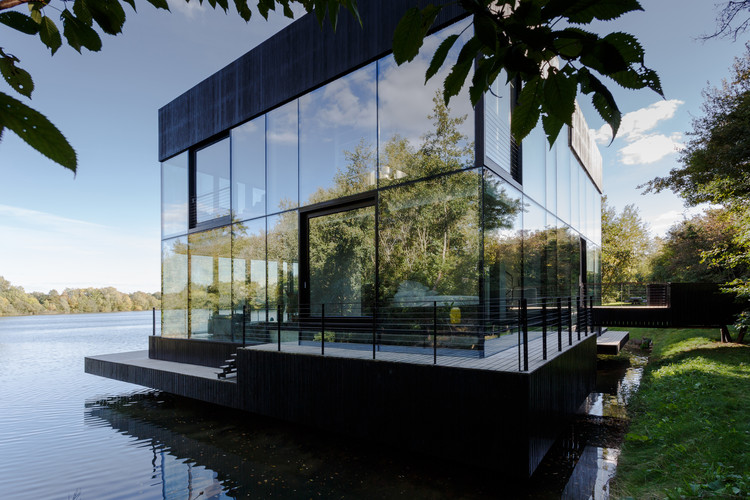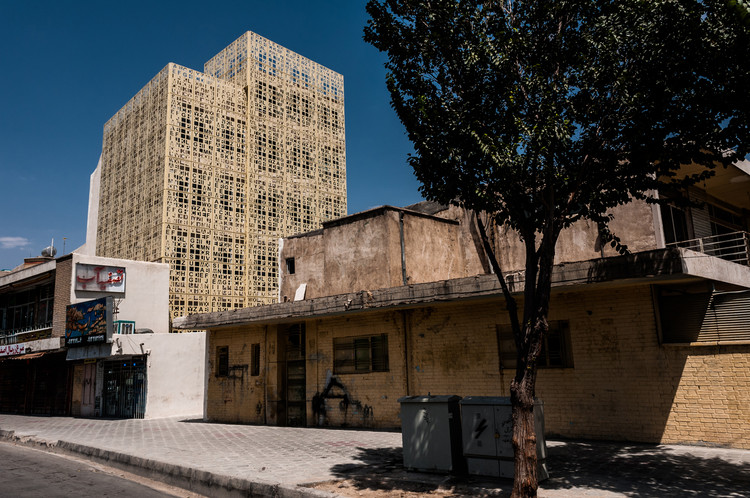Guaiume House 24.7 Arquitetura Design
2014-04-16 01:00
Section AA
AA节


该遗址位于索萨斯,距离坎皮纳斯-圣保罗四个区之一。圣保罗市保留着非常独特的特色,带有省级空气,远离坎皮纳的高度工业化,尽管距离繁忙的市中心只有10公里远。
The site is located in Sousas, one of four districts from the city of Campinas-Sao Paulo, a place that keeps very peculiar characteristics, with provincial air, protected from Campinas high degree of industrialization even though being situated only 10 km from the busy downtown.
© Pedro Kok
(佩德罗角)


这座建筑位于共管公寓的最高部分,俯瞰塞拉达斯卡布拉西南部分,坎皮纳斯的最高点。
The building sits over the highest part of condo and overlooks Serra das Cabras southwest portion, the highest point of Campinas.
Ground Floor Plan


为了整合地形的性质,本课题对地形的上部进行了探索,并提出了不同层次的布局方案。结果确保了4个层次的创建,内部用途不同:车库、服务、居住和宿舍的私人空间。优化的自然资源,如阳光照明和通风指导设计。
In order to integrate the nature of the terrain, the project explores the upper part and proposes the distribution of different levels. The result ensured the creation of 4 levels with internal distinct uses: garage, services, living and private area for the dorms. The optimization of natural resources, such as sun lighting and ventilation guided the design.
© Pedro Kok
(佩德罗角)


房屋规划趋向于L形,使底层和庭院之间能够更好地整合,作为厨房和餐厅的室外延伸。
The house plan tends to an L shape, enabling greater integration between the ground floor and the courtyard, acting as an outdoor extension of the kitchen and dining room.
© Pedro Kok
(佩德罗角)


在立面上,有一个5米长的立方体,悬垂在地形的前面,这一大体积给人一种有趣的轻盈感。南面的立面证明了双高宏伟的开放是合理的,因为这会使大部分房屋的日光变得最佳。
On the facade, a cube form with 5.5m overhangs towards the front of the terrain, giving this large volume an interesting sense of lightness. The south facade justifies the double height grand opening, since that optimizes daylight in a large part of the house.
生物气候特征
Bioclimatic Features
供热系统
Heat generating systems
房子自然加热有两种方式来防止冬天的冷却:
The house is heated naturally in two ways to prevent cooling in winter:
1.由于它的隔热,并以其大部分的釉面地区为东面。
1. Due to its thermal insulation and featuring most of its glazed area to the east.
© Pedro Kok
(佩德罗角)


2.由于它的形状和方向,房子加热的“温室效应”和直接太阳辐射。
2. Due to its shape and orientation, the house heats up by "greenhouse effect" and direct solar radiation.
冷却发电系统
Cooling generation systems
这种设计可以通过以下三种方式自然地提神,以避免夏天的高温:
The design allows refreshing itself naturally in three ways to avoid high temperatures in the summer:
1.有玻璃的南面和太阳保护,例如保护东面的直接太阳辐射。此外,百叶窗保护高达90%的太阳紫外线辐射。
1. Glazed south surfaces and solar protections, such as brise-soleil protecting direct solar radiation on the east facade. Also blinds protect up to 90% of solar UV radiation.
2.寒冷的风穿过阴凉处,降低了它的温度。
2. Chilled winds that pass trough shaded areas, lowering its temperatures.
© Pedro Kok
(佩德罗角)


3.允许热风通过自然对流从房屋流出。自动上窗提取热空气。
3. Allowing hot air flow off the house by natural convection. Automated upper windows extract the hot air.
蓄热系统(加热和冷却)
Accumulation systems (heating and cooling)
Upper Floor Plan
上层平面图


冬季白天产生的热量(来自“温室效应”和直接的太阳辐射)积聚在内壁和板上。因此,家里一整晚都保持温暖,不消耗能源。夏季夜间(通过通风和自然降温)产生的冷却以新鲜空气更新。因此,房子在白天保持凉爽,没有任何能源消耗。
The heat generated during the day in winter (from "greenhouse effect " and direct solar radiation) accumulates on the inner walls and slabs. Thus the home stays warm all night without energy consumption. The cooling generated during the night in summer (from ventilation and natural temperature drop) renews with fresh air. Thus the house remains cool during the day without any energy consumption.
Natural ventilation
© Pedro Kok
(佩德罗角)


住宅的通风是连续而自然的。房子的方向和布置允许盛行的风进入,允许在房子的大多数环境中有足够的通风。放置良好的窗户可以在炎热的日子和高相对湿度的日子持续冷却。
The ventilation of the residence is made continuously and naturally. The orientation and deployment of the house allows the prevailing winds to enter, allowing adequate ventilation in most environments of the house. Well-placed windows allow a continuous flow to cool off on hot days and on days of high relative humidity.
Sustainability
资源优化
Resources Optimization
© Pedro Kok
(佩德罗角)


寻找一个更可持续的设计利用自然资源,如太阳(加热房屋),风(冷却和稳定湿度)和雨水(用于花园浇水,厕所冲洗和外部地区清洁)。
The search for a more sustainable design leverages natural resources such as the sun (to heat the house), wind (to cool and stabilize the humidity) and rainwater (for garden watering, toilet flushing and external areas cleaning).
Low energy consumption
© Pedro Kok
(佩德罗角)


在该项目中,热水是由太阳能集热器产生的,只有在夏季炎热的月份没有足够的自然光和通风来冷却时,才需要在房屋的所有房间都使用天然照明。生物气候设计的主要目的是消除为建筑物提供热量和冷却的技术设备。
In this project, the hot water is generated by solar energy collectors, the natural lighting is prevalent in all rooms of the house, required only when there isn't enough natural light and ventilation for cooling off on hot summer months. The main objective of a bioclimatic design is to eliminate the technological devices that provide heat and cooling in a building.
改善使用者的健康和福祉
Improving users health and wellbeing
家庭通风自然,大部分照明是自然阳光,而且树木产生良好的遮荫区域,这为休闲创造了可能性,为居住者提供了一个健康的环境和改善了生活质量。
The home ventilates naturally and most of the lighting is natural sun light, furthermore has good shaded areas generated by trees, this creates possibilities for leisure, providing a healthy environment and improved quality of life for its occupants.






























Architects 24.7 Arquitetura Design
Location Campinas, Brazil
Category Houses
Architects in Charge Giuliano Pelaio, Gustavo Tenca, Inacio Cardona
Area 305.0 sqm
Project Year 2013
Photographs Pedro Kok
























